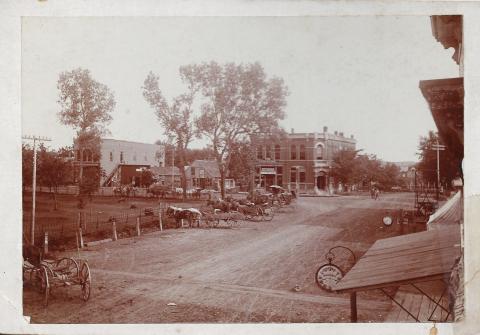This picture was taken in 1899 or 1900 by M. G. Maxwell, a photographer who occupied the upstairs rooms of the Bowlby building at 107 S. Fillmore Street in Mount Ayr, Iowa. The photograph shows the south side of the Mount Ayr town square. The large, two-story brick building in the center of the photo burned down on November 14, 1900. The building housed the Mt. Ayr Bank and Andrew Ingram's general store as well as law offices upstairs and a barber shop downstairs. It was built in 1890. The two-story brick building on the left in the photo was built in 1891 by Thomas Liggett for his grocery store. The upstairs housed many businesses and groups including a dress-making shop, a Grand Army of the Republic post, and law offices. The building was gutted in 1933 and rebuilt as a three-story building using the original walls. The structure served as Dean Jacob's Fur business from about 1930 to the mid-1970s. The clock face near the lower right corner advertises the jewelry and watch repair business of B. W. Vardaman, pioneer jeweler of Mount Ayr. His business was housed on the first floor of the Masonic Lodge located at 111 S. Fillmore Street. This building burned down on September 22, 1927 along with three other buildings on the west side of the Mount Ayr square. The farm implement seen near the right edge sits in front of A. A. Huggins farm implement business located at 121 S. Fillmore Street. He built the building in 1891 and the building still stands today as McDonnell Appliance and Masonic Lodge Faith #179. The street seen in the photo remained dirt until 1915, when it was paved with brick. Content can be used with the following content: 3rd grade SS 3.28 Cultural Contributions in a lesson on town expansion in the early 1900s. For any use other than instructional resources, please check with the organization that owns this item regarding copyright restrictions.
2018.021.011 [Bank]
Legal Status
Ownership of this resource is held by the Mount Ayr Depot Museum and has been provided here for educational purposes only, specifically for use in the Iowa Museum Association's "Teaching Iowa History" project. It may not be downloaded, reproduced or distributed in any format without written permission from the Rights Holder. For information on U.S. and International copyright laws, consult an attorney.

